First drive: 2018 Honda Accord in the UAE
The Honda Accord has been doing perennial battle with the Toyota Camry and the Nissan Altima. Somewhere along the way, the Accord gained a reputation for being a “bit more premium,” possibly due to higher pricing or because the other two started showing up in taxi fleets around the UAE. But while all previous Accords really were just direct rivals to the other two, the new-for-2018 Accord really does pull out all the stops, and finally justifies its rep as being a “bit more premium,” as we found out on our short drive.
For starters, the Accord really is all-new from the ground up, with more rigid construction and lighter in overall weight. Apparently the engine compartment has been reduced in size due to the smaller turbo engines, leading to more space for the cabin, especially in terms of rear legroom and boot space. And while it looks even bigger than before, the 2018 is actually shorter in length and lower in height than the previous model, using design tricks such as the fastback-style roofline to make it appear longer. You may not love the specific details in the styling, but you will definitely like the overall profile.
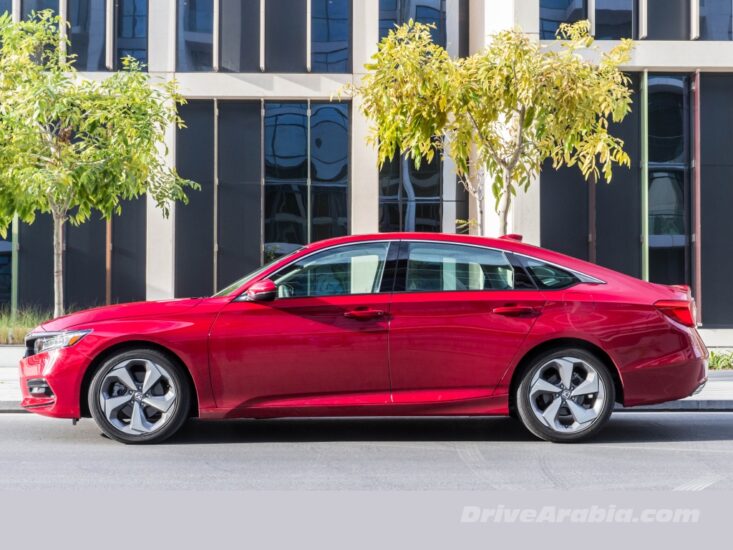
Even base models get dual exhaust tips, LED headlights and tails, and 17-inch alloy wheels. The range includes 1.5T LX, 1.5T Sport, 1.5T EX, 1.5T EX-L and 2.0T Sport. The Sport models exclusively get 18-inch alloys, but it really is hard to distinguish between base and top models.
Inside, the dash design is clean, with a tablet-style infotainment screen plonked on top (7-inch with more buttons on lower-spec cars and 8-inch touchscreen on higher-end trims). The dual-zone auto a/c (also standard on all trims) has its own set of controls and comes with rear vents. Eight airbags are standard, as are ESP, ABS, cruise control, rear sensors, electronic parking brake and tyre-pressure monitoring, while Honda’s “LaneWatch” right-side blindspot camera is available from the EX onwards, but the “Honda Sensing” suite of active-safety features (including adaptive cruise with auto braking, lane-departure mitigation, etc.) and navigation are only available in the 1.5T EX-L and 2.0T Sport models. The 2.0T also gets a better 10-speaker audio system and a heads-up display.
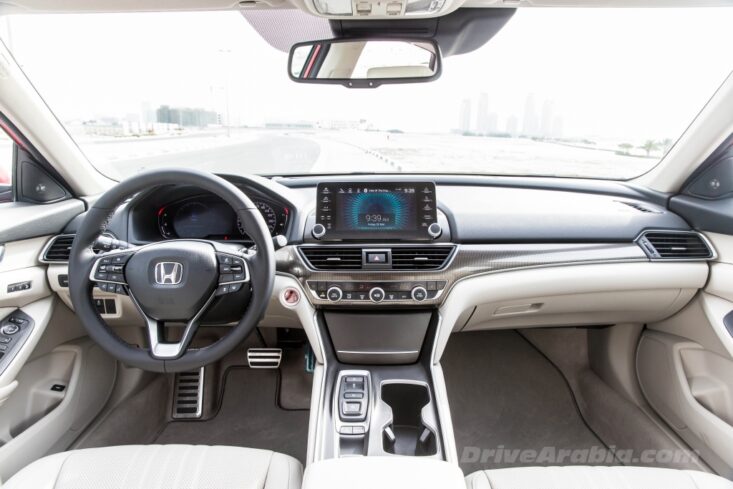
The dash-top, centre-console sides and front upper-door trims are soft-touch padded, but there’s still a bit more hard plastics than we’d like, especially on the rear upper-door panels. Door inserts and armrests are well-padded, and both cloth and leather upholstery options are nicely done.
The new powertrains are modern turbocharged 4-cylinder engines, namely a 198 hp 1.5-litre (with 260 Nm of torque and a CVT automatic) in four trims and a 247 hp 2.0-litre (with 370 Nm and a 10-speed automatic) in just one fully-loaded trim. We briefly drove both on the highway. Interestingly, the 1.5T gets a proper “gear” shifter, while the 2.0T gets “P-R-N-D” as buttons. Only the “Sport” models get paddle shifters and a “sport” mode.
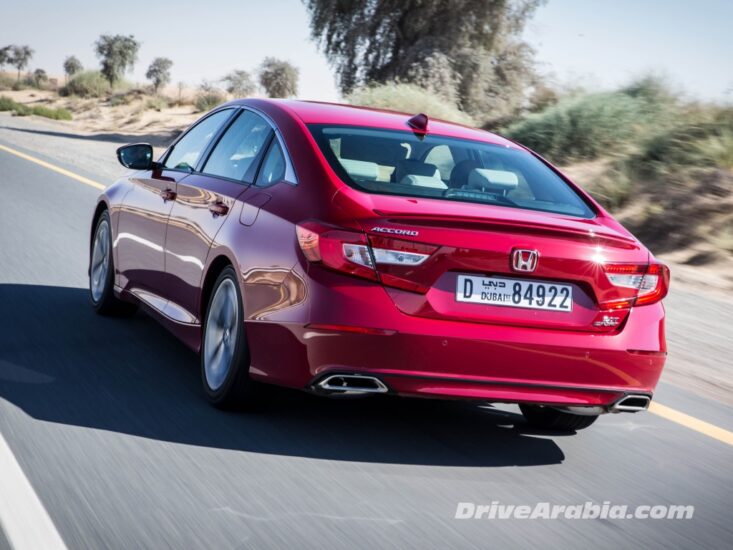
The 1.5T feels decently powerful for daily-driving, although not a rocket by any means. Honda continues to make the best CVTs, which allows the torque to come on early in the rev range rather than “rubber-band” like other CVTs do. The turbo torque peaks from 1600 rpm onwards. And we burned a reasonable 9 litres/100 km (11.1 km/l).
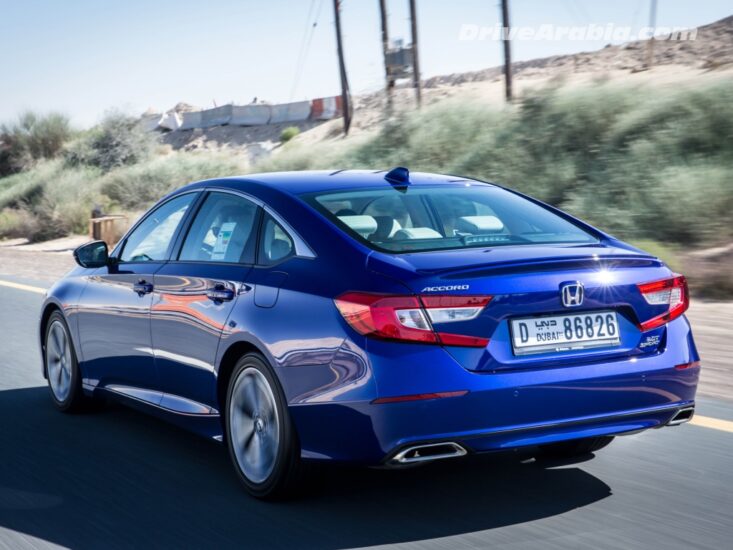
The news-maker is the 2.0T though. Lower on power than the old V6, but gaining a ton of low-end torque that peaks from 1500 rpm onwards. With the help of shorter gears in the class-exclusive 10-speed, the car does massive burnouts if you gun it from a standstill, even with the ESP on. It’s a properly quick car, and can outrun hot hatches in a straight line. We did 10.7 litres/100 km (9.3 km/l), which is rather good for such power.
Out on the road, both cars behave very well, with a fairly smooth ride, better sound-deadening than before, and absolute stability at 160 kph, which is as fast as we took it in our convoy drive.
Around long corners, there is ample grip and limited body roll, with well-weighted electric power steering that offers a bit of feedback, and a drive-by-wire brake pedal that responds instantly and linearly. It’s hard to say how it stacks up against its rivals without a back-to-back drive, but it should be near or at the top on the score board.
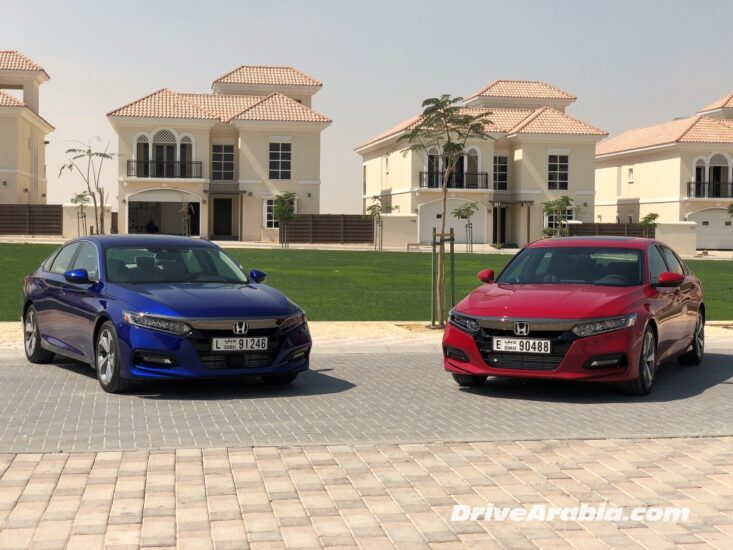
There’s a lot to like about the all-new Accord. We’re glad to see innovation finally make a comeback at Honda in the past year, after selling mostly refrigerators-on-wheels for almost a decade. While the real sporty and innovate stuff have yet to show up at showrooms in the GCC, the turbo Accord is a step in the right direction.
For prices and specs, visit the Honda buyer guide.
Photos by Mashfique H. Chowdhury and Nick England.



















Comments
Murad
The front and interior are quite coOL, while rear is disappointing. 140k For the sport trim is not favorable for this segment!
Hafiz
hope this is made in Japan or some thing.. last time we had made in china … good heavens if it is made india…
Mashfique Hussain Chowdhury
Umreeki.
Prado
dont know if it is just me or honda is making cars that it takes time to digest its looks.
1990s honda accord were so classy… one look and you would like them. At least the interior is top notch looks more composed than the camry.
Mohamed
looks good
i liked the interior more then the exterior.
when Camry review is coming ?
Mashfique Hussain Chowdhury
Our Camry launch invite got “lost in the mail.”
noushad
The front and Interior looks fair, while the rear design is not impressive. Price to be brought down lit bit.
shahanas sharif
Took 2.0t for a spin, fair power, good torque. But where are the 19-inch wheels shod with 235/40R-19? and also chrome handles are missing, NFC? rain sensors? etc.
Looks like only base model for 2.0t is available in uae for now. 140k price needs to come down too.
Suresh
Honda mimicked the BMW Cockpit Dash, could have derived inspiration on the Gear stick as well instead of the current Switch type gear shifter layout.
Rear tail lamp design inspired from Audi.
Dilawar Hussain
I like the white car. is a amasing